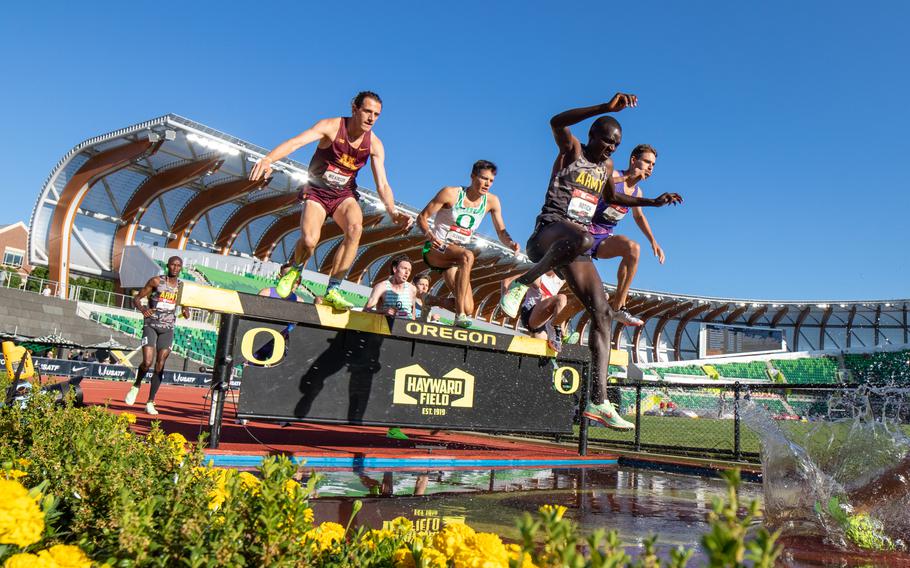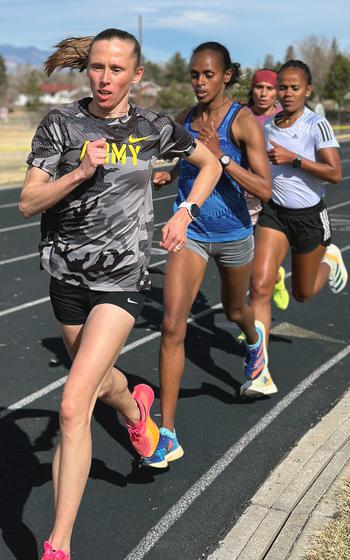
Army Sgt. Anthony Rotich completes the water jump during a men’s 3,000-meter steeplechase race at the 2023 USA Track and Field Outdoor Championships held in Eugene, Ore., July 6, 2023. (Michael Hunnisett/U.S. Army)
EUGENE, Ore. — Two soldiers and an airman will run the length of 30 football fields on Friday, jumping 28 barriers and seven water pools in a race to qualify for the final spots on Team USA and go to Paris next month to compete in the Olympic games.
“If you finish in the top three, you make the team and go to that world stage,” said Sgt. Anthony Rotich, 33, a chemical equipment repairman at Fort Carson, Colo. “If I go, I will consider myself lucky.”
Rotich will race in the 3000-meter steeplechase at the U.S. Olympic Track and Field Trials in Eugene, Ore., which begin Friday. The steeplechase is a combination distance race and obstacle course with jumps and pits that can send athletes crashing to the ground or come up soaking wet if they mis-time the water hazards.
On Friday, Rotich will face a field that includes Army Spc. Benard Keter, 32, and Air Force Airman 1st Class Daniel Michalski, 28. Keter serves at Fort Carson, and Michalski is assigned to the Air Force Services Center near the U.S. Air Force Academy in Colorado Springs, Colo.

Air Force Airman 1st Class Daniel Michalski trains in the service’s World Class Athlete Program in Colorado Springs, Colo., for the 3000-meter steeplechase. He’s competing for the U.S. Olympic team that will go to Paris for the 2024 summer games. (Emily Peacock/U.S. Space Force)
The trio is part of as many as a dozen U.S. service members competing in events at the U.S. Olympic Track and Field Trials in Oregon.
“This is the last of the trials before Paris,” said Aarti Parekh, USA Track & Field spokeswoman.
The final lineup of the team that will march into Paris on July 26 will be set in coming weeks as athletes drop out or are added to the final roster.
Military personnel have already achieved places on the 2024 Team USA in events such as shooting.
The Pentagon hopes to surpass the 2020 Olympic Games in Tokyo and the 2022 Winter Games in Beijing, when 19 military athletes competed. U.S. military personnel on the Olympic team is a boost to the services, which often place the athletes in recruiting videos and send them to community events across the country between competitions.
“It’s great having a front-row seat to see all of these athletes train and excel at their competitions,” said Dale Filsell, chief of the Air Force World Class Athlete Program. “All of the athletes are ready to take that extra step toward making Team USA.”
A native of Kenya, Rotich joined the Army Reserve after attending the University of Texas at El Paso. Basic training and his military service on the chemical inspection team have helped him develop new resilience and boost his confidence, he said.
“If there was one aspect of life I did not have as a civilian, it was how to persevere and endure,” Rotich said.
After enduring some injuries in training in recent years, Rotich said Army discipline kicked in and he rebounded to a competitive level.
“In the Army, you know that the storm is going to come, so you are calm when the storm does come,” he said. “If there are bad conditions, you bounce back from bad conditions. You don’t quit on yourself or your team.”

Army Spc. Bernard Keter is competing for a spot on the 2024 U.S. Olympic team in the 3000-meter steeplechase. (U.S. Army)
Keter’s climb up the rankings to Olympic hopeful took a major leap in the fall when he finished second in the steeplechase at the U.S. national championships in Oregon.
“The Army has taught me a lot about being competitive and has also helped me build a proud tradition of service and success both on and off the track,” he said.
In addition to Rotich and Keter, soldiers competing in Oregon include Sgt. Collet Rampf, 30, who is running the women’s 3,000-meter steeplechase, Spc. Reginald Jagers, 29, who is throwing the discus, and Spc. Aldrich Bailey, 30, who is running the 400-meter hurdles.
Rampf, a native of Germany who became an American citizen, said she was excited for a chance to go to Paris representing the United States and the Army.

Army Sgt. Collet Rampf is running for a spot on the U.S. Olympic Team to compete in the 3000-meter steeplechase. (Shannon Collins/U.S. Army)
“It’s important to have opportunities like these to help advance your career both as a soldier and as an elite athlete,” she said. “I want to represent the Army the best way I can. It would mean a lot to me.”
During a break in training in the fall, Michalski told an Air Force publication that he was running up to 70 miles per week to give his best for his country, the Air Force and his family, which has supported long training regimes and time away from home for events.
“I think it would mean so much to me, my family, my coaches — everyone that’s sacrificed for and supported my journey,” Michalski said.
Joining Michalski in representing the Air Force is Senior Airman Michael Mannozzi, 38, who competes in the 35-kilometer racewalk.
Navy officials this week did not report any sea service athletes competing in Oregon.
However, four student-athletes with the U.S. Naval Academy in Annapolis, Md., are competing, according to the school’s sports department.
A pair of 2024 U.S. Naval Academy graduates Brahmir Vick, 22, and Braden Presser, 24, will compete in Oregon. Vick is entered in the 110 meter hurdles, and Presser will compete in the javelin event. Annapolis midshipman Jacques Guillaume, a senior, will compete in the 400-meter hurdles. Nathan Kent, a junior who plays wide receiver for the academy’s football team, will race in the 400 meters.
The Army and Air Force have special programs that allow athletes able to compete on an international level by providing training space and support. The Navy encourages sailors and Marines to compete but doesn’t provide a separate program to put them on the path to the Olympics.
The goal is to add to the roster of U.S. military Olympians — and medal winners — that goes back to the 1912 Olympics in Stockholm, where Gen. George S. Patton competed in the modern pentathlon — five events that included shooting, swimming, fencing, horsemanship and cross-country running. More recently Army Lt. Amber English won the gold medal as a women’s skeet shooter in the 2020 Tokyo Olympics.
The Army has sent the largest number of athletes to the Olympics since World War II. According to the Army, 446 soldiers have represented the United States at the Olympics, earning 111 medals in various sports.
The Army’s World Class Athlete Program pulls its talent from the active-duty, Reserve and National Guard components.
The program is not used to develop athletes but allow those who already achieved international-level status to work on their sports and represent the United States in competitions worldwide.
“They are already world-class,” said Maj. Nathaniel Garcia, spokesman for track and field athletes with the Army program.
The Army program supports military athletes in boxing, wrestling, track and field, modern pentathlon, archery, shooting, taekwondo, rugby and various winter sports. It also supports top Paralympic athletes in swimming, archery, and shooting.
There largest group competing this week are four service members racing in the steeplechase. A combination of distance running and obstacle course, it covers 3,000 meters — the equivalent of 3,281 yards.
Rotich is ranked 30th in the world — and third in the United States — by World Athletics, the name since 2019 of 112-year-old International Amateur Athletic Federation. Keter is ranked 51st in the world, and Michalski is ranked 82nd. Rampf is ranked 110th in the women’s field.
When Rotich lines up for the preliminary 3000-meter race with an Air Force competitor, he said he will be far from any “Army beat Navy beat Air Force” service rivalry. He would be proud if all three service members made Team USA.
“We will all carry the same flag of the United States,” he said.
A sampling of past military Olympians:
Some of the top Olympic medal winners who served in the U.S. military, according to a list compiled by the Defense Department:
George S. Patton: The Army general was a member of the 1912 American team that competed in the Summer Olympics in Stockholm.
Charley Paddock: Between serving in the Army in World War I and the Marine Corps in World War II, Paddock competed in the 1920 Olympic Games in Antwerp 1920 and the 1924 Olympic Games in Paris. He won two gold medals and two silver medals
Jack Kelley Sr.: Served in the Army in World War I and won three gold medals in rowing.
Eddie Eagan: The soldier won gold medals in boxing and bobsledding — the only Olympian to win gold medals in the summer and winter games.
John Woodruff: After his 800-meter win at the 1936 games in Berlin, he served as an Army officer in World War II and the Korean War.
Louis Zamperini: A distance runner who set a single-lap record at the 1936 games in Berlin. He served in the Army Air Force in the Pacific during World War II.
Harrison Dillard: He served three years in the Army during World War II in the all-Black 92nd Infantry Division. After the war, he won four gold medals in track events in two Olympics.
John Davis: Served in the Army in the Pacific for four years during World War II. He won gold medals at the Olympics in London in 1948 and in Helsinki in 1952.
Sammy Lee: An Army reservist who served in the Korean War. He won two gold medals and one bronze in diving in two Olympic games.
Mal Whitfield: Served in the all-Black Tuskegee Airmen during World War II and later in Korea. He won five track medals — including three gold medals — in two Olympic Games.
Willie Davenport: The runner was in the Army when he qualified for the Tokyo Olympics in 1964. He won gold and bronze medals while competing in five summer Olympics.
Billy Mills: A Marine who won the gold medal in the 10,000 meters at the 1964 Tokyo Olympics.
Lones Wigger: The soldier served two tours in the Vietnam War while competing in three Olympic games, winning two gold medals and one bronze in shooting events.
David Robinson: A graduate of the U.S. Naval Academy in Annapolis, Md., he was part of the U.S. men’s basketball team in the Olympics while still in the Navy. After leaving the Navy and becoming an NBA player, he competed in two more Olympics.
Amber English: Army lieutenant who set an Olympic record by hitting 56 of 60 targets in women’s skeet on her way to a gold medal at the 2020 Olympics in Tokyo.
Vincent Hancock: Soldier who won a gold medal in men’s skeet at the 2012 games in London.
Elizabeth Marks: An Army combat medic who won gold, silver and bronze medals in swimming events in the 2020 Paralympics in Tokyo. She had also won gold and bronze medals in Rio de Janeiro in 2016.